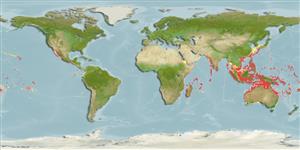Common names from other countries
Environment: milieu / climate zone / depth range / distribution range
экология
ассоциированный с рифами; пределы глубины 0 - 73 m (Ref. 81548). Tropical
Indo-West Pacific.
Length at first maturity / Size / Вес / Возраст
Maturity: Lm ? range ? - ? cm
Inhabits reef areas from intertidal zone at depths of 2 to 15 m (Ref. 800). Exposed on open substrates. Rarely observed on reef flats and lagoon and very rare on seaward reef (Ref. 102252). Feeds on organic material and microinvertebrates. Reproduces asexually by fission (Ref. 800).
Life cycle and mating behavior
половая зрелость | размножение | нерест | икра | Fecundity | личинки
Members of the class Asteroidea exhibit both asexual (regeneration and clonal) and sexual (gonochoric) means of reproduction. Life cycle: Embryos hatch into planktonic larvae and later metamorphose into pentamorous juveniles which develop into young sea stars with stubby arms.
Основная ссылка
ссылки | координатор | соавторы
Schoppe, S. 2000. (Ref. 800)
Статус Красного Списка МСОП (Ref. 130435)
Статус СИТЕС (Ref. 108899)
Not Evaluated
Not Evaluated
Угроза для людей
Harmless
Использование человеком
| FishSource |
инструменты
дополнительная информация
Возраст/Размеры
рост
Зависимость между длиной и массой тела
Зависимость между длинами
морфология
личинки
численность
ресурсы в Интернет
Estimates based on models
Preferred temperature
(Ref.
115969): 24.2 - 28.9, mean 27.6 (based on 944 cells).
Категория цены
Unknown.
